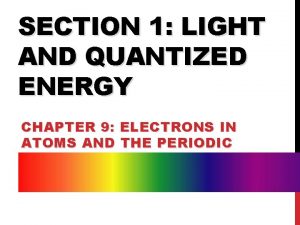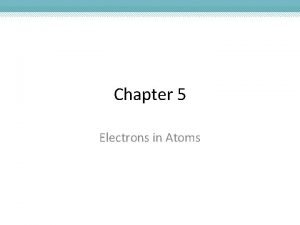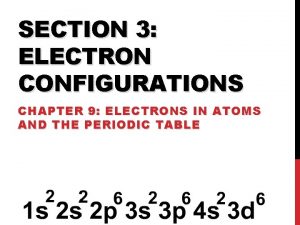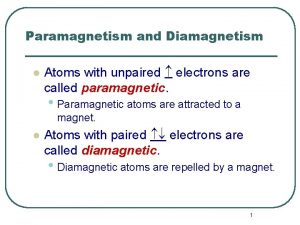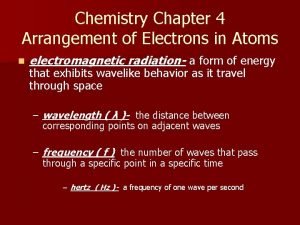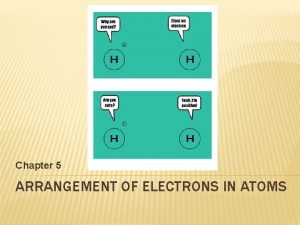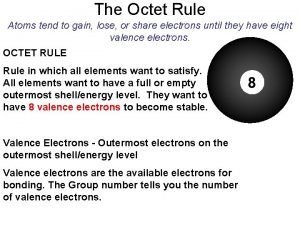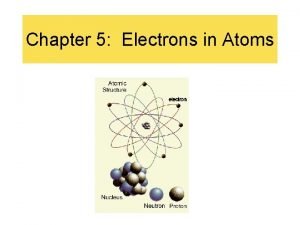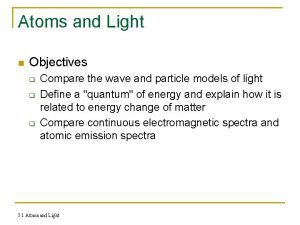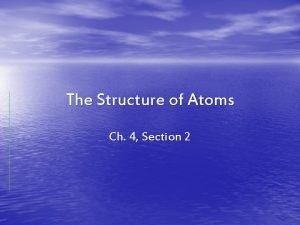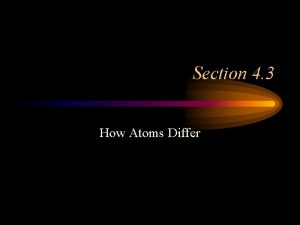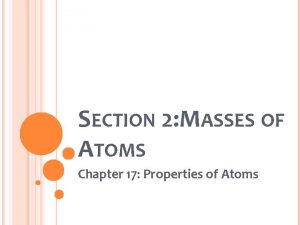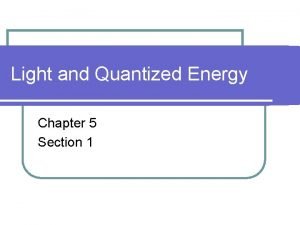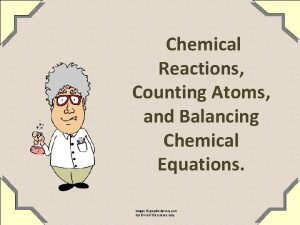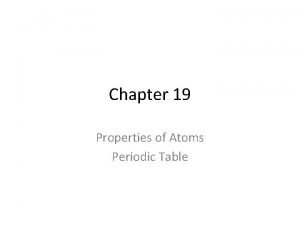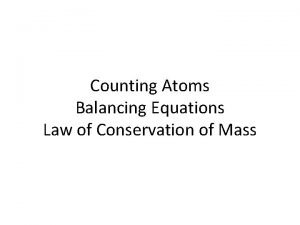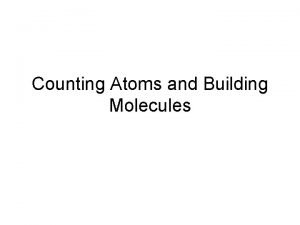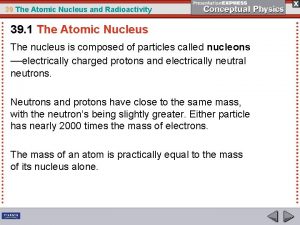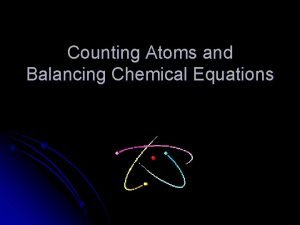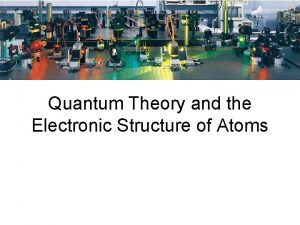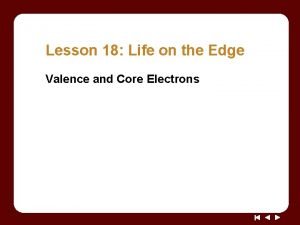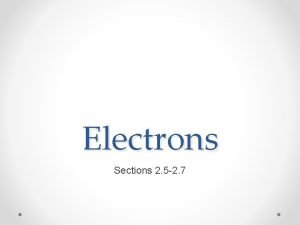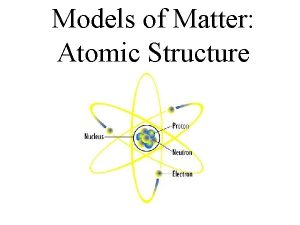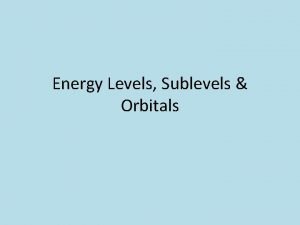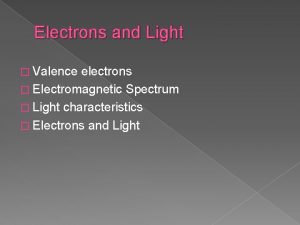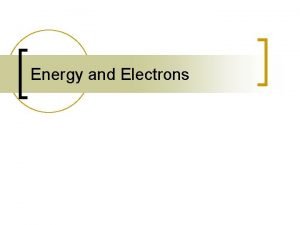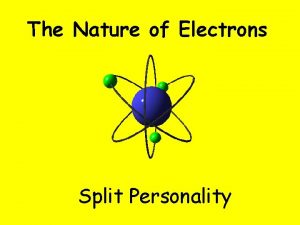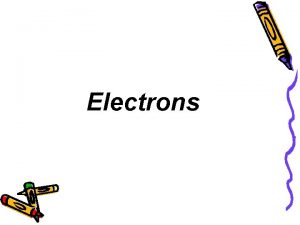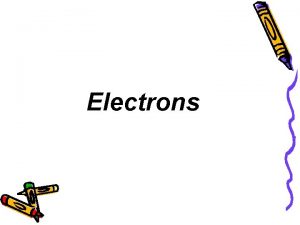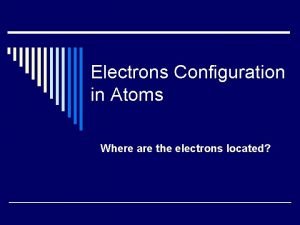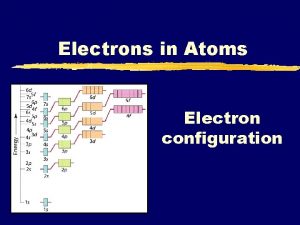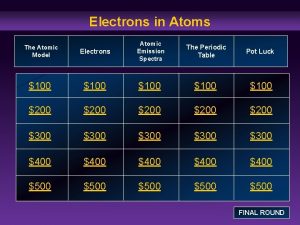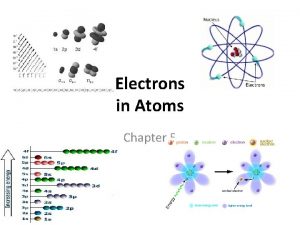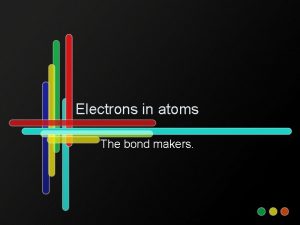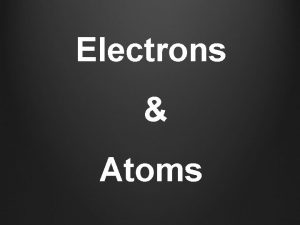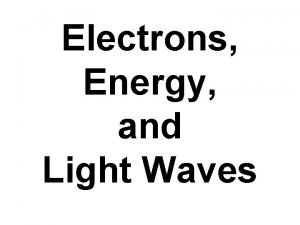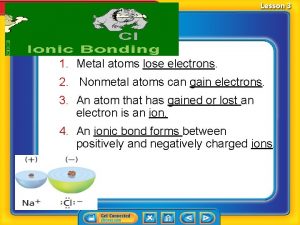Electrons in Atoms Section 5 1 Light and



























































- Slides: 59


Electrons in Atoms Section 5. 1 Light and Quantized Energy Section 5. 2 Quantum Theory and the Atom Section 5. 3 Electron Configuration Click a hyperlink or folder tab to view the corresponding slides. Exit

Section 5. 1 Light and Quantized Energy • Compare the wave and particle natures of light. • Define a quantum of energy, and explain how it is related to an energy change of matter. • Contrast continuous electromagnetic spectra and atomic emission spectra. radiation: the rays and particles —alpha particles, beta particles, and gamma rays—that are emitted by radioactive material

Section 5. 1 Light and Quantized Energy (cont. ) electromagnetic radiation quantum wavelength Planck's constant frequency photoelectric effect amplitude photon electromagnetic spectrum atomic emission spectrum Light, a form of electronic radiation, has characteristics of both a wave and a particle.

The Atom and Unanswered Questions • Recall that in Rutherford's model, the atom’s mass is concentrated in the nucleus and electrons move around it. • The model doesn’t explain how the electrons were arranged around the nucleus. • The model doesn’t explain why negatively charged electrons aren’t pulled into the positively charged nucleus.

The Atom and Unanswered Questions (cont. ) • In the early 1900 s, scientists observed certain elements emitted visible light when heated in a flame. • Analysis of the emitted light revealed that an element’s chemical behavior is related to the arrangement of the electrons in its atoms.

The Wave Nature of Light • Visible light is a type of electromagnetic radiation, a form of energy that exhibits wave-like behavior as it travels through space. • All waves can be described by several characteristics.

The Wave Nature of Light (cont. ) • The wavelength (λ) is the shortest distance between equivalent points on a continuous wave. • The frequency (ν) is the number of waves that pass a given point per second. • The amplitude is the wave’s height from the origin to a crest.

The Wave Nature of Light (cont. )

The Wave Nature of Light (cont. ) • The speed of light (3. 00 108 m/s) is the product of it’s wavelength and frequency c = λν.

The Wave Nature of Light (cont. ) • Sunlight contains a continuous range of wavelengths and frequencies. • A prism separates sunlight into a continuous spectrum of colors. • The electromagnetic spectrum includes all forms of electromagnetic radiation.

• 5. 1 Calculating the wavelength of an EM wave # 1 -2 p. 140 c = λν • 1. Light reflected from a green leaf is found to have a wavelength of 4. 90 X 10 -7 m. What is the frequency of the light? – 3. 00 X 108 m/s = (4. 90 X 10 -7 m) v – V= 6. 12 X 1014 Hz • 2. What is the frequency of an X ray with a wavelength of 1. 15 X 10 -10 m? – 3. 00 X 108 m/s = (1. 15 X 10 -10 m) v – V = 2. 61 X 1018 Hz

The Particle Nature of Light • The wave model of light cannot explain all of light’s characteristics. • Matter can gain or lose energy only in small, specific amounts called quanta. • A quantum is the minimum amount of energy that can be gained or lost by an atom. • Planck’s constant has a value of 6. 626 10– 34 J ● s.

The Particle Nature of Light (cont. ) • The photoelectric effect is when electrons are emitted from a metal’s surface when light of a certain frequency shines on it.

The Particle Nature of Light (cont. ) • Albert Einstein proposed in 1905 that light has a dual nature. • A beam of light has wavelike and particlelike properties. • A photon is a particle of electromagnetic radiation with no mass that carries a quantum of energy. Ephoton = h Ephoton represents energy. h is Planck's constant. represents frequency.

5. 1 Calculating the energy of a photon # 5 p. 143 Ephoton = h Ephoton represents energy. h is Planck's constant. represents frequency. h = 6. 626 10– 34 J ● s 5. Calculate the energy for the following photons. a) 6. 32 X 1020 s-1 Ephoton = (6. 626 10– 34 J ● s)(6. 32 X 1020 s-1) Ephoton = 4. 19 X 10 -13 J

• b) 9. 50 X 1013 Hz Ephoton = (6. 626 X 10– 34 J ● s)(9. 50 X 1013 Hz ) Ephoton = 6. 29 X 10 -20 J • c) 1. 05 X 1016 s-1 Ephoton = (6. 626 X 10– 34 J ● s)(1. 05 X 1016 s-1 ) Ephoton = 6. 96 X 10 -18 J

Atomic Emission Spectra • Light in a neon sign is produced when electricity is passed through a tube filled with neon gas and excites the neon atoms. • The excited atoms emit light to release energy.

Atomic Emission Spectra (cont. ) • The atomic emission spectrum of an element is the set of frequencies of the electromagnetic waves emitted by the atoms of the element. • Each element’s atomic emission spectrum is unique.

Section 5. 1 Assessment What is the smallest amount of energy that can be gained or lost by an atom? A. electromagnetic photon B. beta particle C. quanta D. wave-particle A. B. C. D. A B C D

Section 5. 1 Assessment What is a particle of electromagnetic radiation with no mass called? A. beta particle B. alpha particle C. quanta D. photon A. B. C. D. A B C D


Section 5. 2 Quantum Theory and the Atom • Compare the Bohr and quantum mechanical models of the atom. • Explain the impact of de Broglie's wave article duality and the Heisenberg uncertainty principle on the current view of electrons in atoms. • Identify the relationships among a hydrogen atom's energy levels, sublevels, and atomic orbitals. atom: the smallest particle of an element that retains all the properties of that element, is composed of electrons, protons, and neutrons.

Section 5. 2 Quantum Theory and the Atom (cont. ) ground state quantum number de Broglie equation Heisenberg uncertainty principle quantum mechanical model of the atomic orbital principal quantum number principal energy level energy sublevel Wavelike properties of electrons help relate atomic emission spectra, energy states of atoms, and atomic orbitals.

Bohr's Model of the Atom • Bohr correctly predicted the frequency lines in hydrogen’s atomic emission spectrum. • The lowest allowable energy state of an atom is called its ground state. • When an atom gains energy, it is in an excited state.

Bohr's Model of the Atom (cont. ) • Bohr suggested that an electron moves around the nucleus only in certain allowed circular orbits.

Bohr's Model of the Atom (cont. ) • Each orbit was given a number, called the quantum number.

Bohr's Model of the Atom (cont. ) • Hydrogen’s single electron is in the n = 1 orbit in the ground state. • When energy is added, the electron moves to the n = 2 orbit.

Bohr's Model of the Atom (cont. )

Bohr's Model of the Atom (cont. )

Bohr's Model of the Atom (cont. ) • Bohr’s model explained the hydrogen’s spectral lines, but failed to explain any other element’s lines. • The behavior of electrons is still not fully understood, but it is known they do not move around the nucleus in circular orbits.

The Quantum Mechanical Model of the Atom • Louis de Broglie (1892– 1987) hypothesized that particles, including electrons, could also have wavelike behaviors.

The Quantum Mechanical Model of the Atom (cont. ) • The figure illustrates that electrons orbit the nucleus only in whole-number wavelengths.

The Quantum Mechanical Model of the Atom (cont. ) • The de Broglie equation predicts that all moving particles have wave characteristics. represents wavelengths h is Planck's constant. m represents mass of the particle. represents frequency.

The Quantum Mechanical Model of the Atom (cont. ) • Heisenberg showed it is impossible to take any measurement of an object without disturbing it. • The Heisenberg uncertainty principle states that it is fundamentally impossible to know precisely both the velocity and position of a particle at the same time. • The only quantity that can be known is the probability for an electron to occupy a certain region around the nucleus.

The Quantum Mechanical Model of the Atom (cont. )

The Quantum Mechanical Model of the Atom (cont. ) • Schrödinger treated electrons as waves in a model called the quantum mechanical model of the atom. • Schrödinger’s equation applied equally well to elements other than hydrogen.

The Quantum Mechanical Model of the Atom (cont. ) • The wave function predicts a threedimensional region around the nucleus called the atomic orbital.

Hydrogen Atomic Orbitals • Principal quantum number (n) indicates the relative size and energy of atomic orbitals. • n specifies the atom’s major energy levels, called the principal energy levels.

Hydrogen Atomic Orbitals (cont. ) • Energy sublevels are contained within the principal energy levels.

Hydrogen Atomic Orbitals (cont. ) • Each energy sublevel relates to orbitals of different shape.

Hydrogen Atomic Orbitals (cont. )

Section 5. 2 Assessment Which atomic suborbitals have a “dumbbell” shape? A. s B. f C. p D. d A. B. C. D. A B C D

Section 5. 2 Assessment Who proposed that particles could also exhibit wavelike behaviors? A. Bohr B. Einstein C. Rutherford D. de Broglie A. B. C. D. A B C D


Section 5. 3 Electron Configuration • Apply the Pauli exclusion principle, the aufbau principle, and Hund's rule to write electron configurations using orbital diagrams and electron configuration notation. • Define valence electrons, and draw electron-dot structures representing an atom's valence electrons. electron: a negatively charged, fast-moving particle with an extremely small mass that is found in all forms of matter and moves through the empty space surrounding an atom's nucleus

Section 5. 3 Electron Configuration (cont. ) electron configuration aufbau principle Pauli exclusion principle Hund's rule valence electrons electron-dot structure A set of three rules determines the arrangement in an atom.

Ground-State Electron Configuration • The arrangement of electrons in the atom is called the electron configuration. • The aufbau principle states that each electron occupies the lowest energy orbital available.

Ground-State Electron Configuration (cont. )

Ground-State Electron Configuration (cont. ) • The Pauli exclusion principle states that a maximum of two electrons can occupy a single orbital, but only if the electrons have opposite spins. • Hund’s rule states that single electrons with the same spin must occupy each equal-energy orbital before additional electrons with opposite spins can occupy the same energy level orbitals.

Ground-State Electron Configuration (cont. )

Ground-State Electron Configuration (cont. ) • Noble gas notation uses noble gas symbols in brackets to shorten inner electron configurations of other elements.

Ground-State Electron Configuration (cont. ) • The electron configurations (for chromium, copper, and several other elements) reflect the increased stability of half-filled and filled sets of s and d orbitals. • 5. 3 Electron Arrangement # 21 p. 160

Name Symbol Atomic # Electron Configuration Bromine Br 35 1 s 2 2 p 6 3 s 2 3 p 6 4 s 2 3 d 10 4 p 5 Strontium Sr 38 1 s 2 2 p 6 3 s 2 3 p 6 4 s 2 3 d 10 4 p 6 5 s 2 Antimony Sb 51 1 s 2 2 p 6 3 s 2 3 p 6 4 s 2 3 d 10 4 p 6 5 s 2 4 d 10 5 p 3 Rhenium Re 75 1 s 2 2 p 6 3 s 2 3 p 6 4 s 2 3 d 10 4 p 6 5 s 2 4 d 10 5 p 6 6 s 2 4 f 14 5 d 5 Terbium Tb 65 1 s 2 2 p 6 3 s 2 3 p 6 4 s 2 3 d 10 4 p 6 5 s 2 4 d 10 5 p 6 6 s 2 4 f 9 Titanium Ti 22 1 s 2 2 p 6 3 s 2 3 p 6 4 s 2 3 d 2

Valence Electrons • Valence electrons are defined as electrons in the atom’s outermost orbitals— those associated with the atom’s highest principal energy level. • Electron-dot structure consists of the element’s symbol representing the nucleus, surrounded by dots representing the element’s valence electrons. • 5. 3 Electron Dot Structures #26 p. 162

26. Draw electron-dot structures for atoms of the following elements. Name Atomic # Nobel Gas Notation Magnesium 12 [Ne] 3 s 2 Thallium 81 [Xe] 6 s 2 4 f 14 5 d 10 6 p 1 Xenon 54 [Kr] 5 s 2 4 d 10 5 p 6 Electron-dot structure

Valence Electrons (cont. )

Section 5. 3 Assessment In the ground state, which orbital does an atom’s electrons occupy? A. the highest available B. the lowest available C. the n = 0 orbital D. the d suborbital A. B. C. D. A B C D

Section 5. 3 Assessment The outermost electrons of an atom are called what? A. suborbitals B. orbitals C. ground state electrons D. valence electrons A. B. C. D. A B C D
 Electrons in atoms section 1 light and quantized energy
Electrons in atoms section 1 light and quantized energy Electrons in atoms section 1 light and quantized energy
Electrons in atoms section 1 light and quantized energy The lowest allowable energy state of an atom is called
The lowest allowable energy state of an atom is called Electrons in atoms section 2 quantum theory and the atom
Electrons in atoms section 2 quantum theory and the atom Copper subshell configuration
Copper subshell configuration Periodic table regents
Periodic table regents Atoms with 4 valence electrons
Atoms with 4 valence electrons Atoms with unpaired electrons are called diamagnetic.
Atoms with unpaired electrons are called diamagnetic. Label an atom
Label an atom Chapter 4 arrangement of electrons in atoms
Chapter 4 arrangement of electrons in atoms Stable electron configurations are likely to contain
Stable electron configurations are likely to contain Chapter 5 arrangement of electrons
Chapter 5 arrangement of electrons Atoms tend to gain lose or share electrons
Atoms tend to gain lose or share electrons How do chemists model the valence electrons of metal atoms?
How do chemists model the valence electrons of metal atoms? Ionic and metallic bonding chapter 7 practice problems
Ionic and metallic bonding chapter 7 practice problems 5 electrons in atoms
5 electrons in atoms Light light light chapter 23
Light light light chapter 23 Light light light chapter 22
Light light light chapter 22 Chapter 22
Chapter 22 Electrons and light pogil activity 5-1
Electrons and light pogil activity 5-1 Chemistry in biology section 2 chemical reactions
Chemistry in biology section 2 chemical reactions Chapter 6 section 1 atoms elements and compounds
Chapter 6 section 1 atoms elements and compounds Chapter 6 section 1 atoms elements and compounds
Chapter 6 section 1 atoms elements and compounds Chapter 4 section 2 the structure of atoms
Chapter 4 section 2 the structure of atoms Section 3 how atoms differ
Section 3 how atoms differ Section 2 masses of atoms
Section 2 masses of atoms Put out the light then put out the light
Put out the light then put out the light Difference between light dependent and light independent
Difference between light dependent and light independent The bouncing off of light
The bouncing off of light Section 1 light and quantized energy
Section 1 light and quantized energy Section 1 light and quantized energy
Section 1 light and quantized energy Section 2 air noise and light pollution
Section 2 air noise and light pollution Section 2 air noise and light pollution
Section 2 air noise and light pollution What material block the light
What material block the light Cutting plane line symbol/image
Cutting plane line symbol/image Section 2 describing energy (continued)
Section 2 describing energy (continued) What is the relationship between atoms and elements
What is the relationship between atoms and elements Compound substance
Compound substance Counting atoms examples
Counting atoms examples Properties of atoms and the periodic table
Properties of atoms and the periodic table Mit center for bits and atoms
Mit center for bits and atoms Balancing equations counting atoms
Balancing equations counting atoms How can you count atoms and molecules
How can you count atoms and molecules Datación radiométrica
Datación radiométrica Counting atoms and balancing equations worksheet
Counting atoms and balancing equations worksheet Isotopes pogil
Isotopes pogil Atoms molecules and ions
Atoms molecules and ions Atoms molecules and ions
Atoms molecules and ions Atoms molecules and ions
Atoms molecules and ions Atoms molecules and ions
Atoms molecules and ions Atoms ions and molecules
Atoms ions and molecules Atoms ions and molecules
Atoms ions and molecules Quantum theory and the electronic structure of atoms
Quantum theory and the electronic structure of atoms Collision theory states that
Collision theory states that Chapter 2 atoms molecules and ions
Chapter 2 atoms molecules and ions Life on the edge valence and core electrons
Life on the edge valence and core electrons How to determine valence electrons
How to determine valence electrons Delocalized vs localized
Delocalized vs localized Sulfur number of neutrons protons and electrons
Sulfur number of neutrons protons and electrons Energy level sublevel orbital
Energy level sublevel orbital
